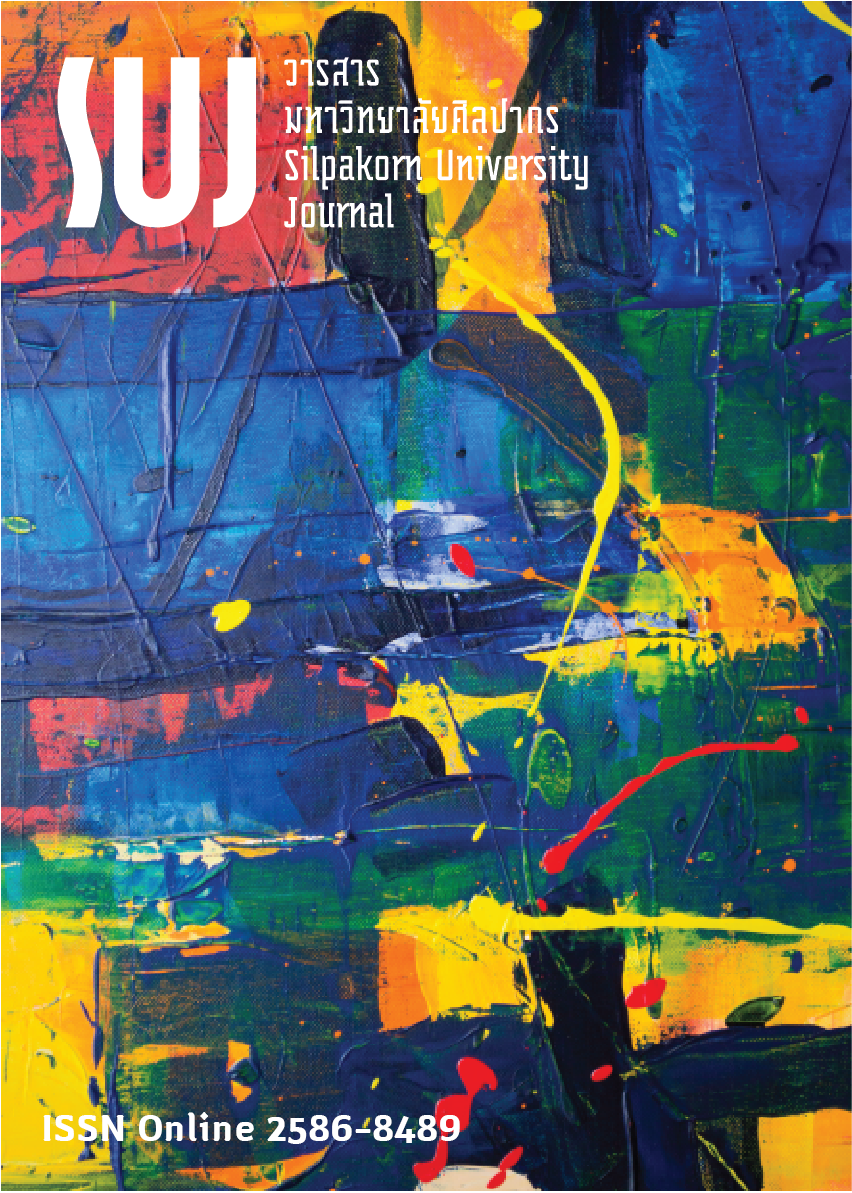ปัจจัยที่มีอิทธิพลต่อการกลับมาเที่ยวซ้ำของนักท่องเที่ยวเชิงสุขภาพจังหวัดมหาสารคาม (Factors affecting revisiting of health tourists in Maha Sarakham province)
Main Article Content
Abstract
บทความวิจัยนี้มีวัตถุประสงค์เพื่อศึกษา 1. สถานการณ์ปัจจุบันของการท่องเที่ยวเชิงสุขภาพ และ 2. ปัจจัยที่มีอิทธิพลต่อการกลับมาเที่ยวซ้ำของนักท่องเที่ยวเชิงสุขภาพจังหวัดมหาสารคาม โดยใช้แบบสอบถามในการเก็บรวบรวมข้อมูล สถิติที่ใช้ในการวิเคราะห์ข้อมูล ได้แก่ ค่าความถี่ ค่าร้อยละ ส่วนเบี่ยงเบนมาตรฐาน ค่าเฉลี่ย และค่าเฉลี่ยถ่วงน้ำหนัก ผลการวิจัยพบว่า นักท่องเที่ยวเชิงส่งเสริมสุขภาพส่วนใหญ่อยู่ในช่วงอายุระหว่าง 51-60 ปี มีทั้งนักท่องเที่ยวทั่วไป และนักทัศนาจร มีการค้นหาข้อมูลแหล่งท่องเที่ยวจากสื่อออนไลน์และคนรู้จัก เดินทางท่องเที่ยวพร้อมครอบครัว ส่วนใหญ่ท่องเที่ยวเพื่อพักผ่อนและไหว้เคารพบูชาสิ่งศักดิ์สิทธิ์ กิจกรรมด้านสุขภาพที่นักท่องเที่ยวสนใจ ได้แก่ การนวด อาหารพื้นบ้าน การใช้ผลิตภัณฑ์สมุนไพรและกิจกรรมที่เกี่ยวเนื่องกับอาหารสุขภาพ รวมถึงนักท่องเที่ยวคำนึงถึงความปลอดภัยและคุณภาพของผลิตภัณฑ์จากพืชสมุนไพรมาเป็นอันดับแรก ซึ่งเมื่อนักท่องเที่ยวมีความพอใจในการที่จะบอกเล่าประสบการณ์หลังจากที่ได้เดินทางท่องเที่ยวต่อคนอื่น ๆ ย่อมเป็นปัจจัยที่มีอิทธิพลต่อการกลับมาเที่ยวซ้ำดังกล่าว
The objective of this research article is to study 1. the current situation of health tourism and 2. factors affecting revisiting of health tourists in Maha Sarakham Province. Used for a sample group included 400 Thai tourists, and questionnaires. The statistical methods used for data analysis were frequency, percentage, standard deviation, mean and weighted average. The findings revealed that most of the health tourists were adults aged between 51-60 years old. They were both general tourists and short stay tourists. Most of them traveled for recreational purposes and to worship sacred things. The health-related activities included massage, eating local food, using herbal products, and eating healthy food. Most of the tourists took safety and quality of herbal products as priority. When the tourists are satisfied with the trips and happy to share their experiences after their traveling to other people, it will cause the factors that influence on the revisiting.
Downloads
Article Details

This work is licensed under a Creative Commons Attribution-NonCommercial-NoDerivatives 4.0 International License.
References
Brooker, E., & Joppe, M. (2014). Developing a Tourism Innovation Typology: Leveraging Liminal Insights. Journal of Travel Research, 53(4): 1-14.
Chaisen, Chainan. (2019). Health Tourism and Innovative Development of Healthy Food for Hotels in Phuket (การท่องเที่ยวเชิงสุขภาพและนวัตกรรมการพัฒนาอาหารเพื่อสุขภาพสำหรับโรงแรม ในจังหวัดภูเก็ต). Veridian E-Journal, Silpakorn University, 12(5): 262-282.
Chen, C. C., Huang, W. J., & Petrick, J. F. (2016). Holiday Recovery Experiences, Tourism Satisfaction and Life Satisfaction-Is There a Relationship? Tourism Management, 53: 140-147.
Chen, C. F., & Tsai, D. (2007). How Destination Image and Evaluative Factors Affect Behavioral Intentions. Tourism Management, 28(4): 1115-1122.
Chitangwattana, Boonlert. (2005). Marketing Management for Tourism Industry (การจัดการด้านการตลาดสำหรับอุตสาหกรรมการท่องเที่ยว). Nonthaburi: Press and Design.
Chuaybumrung, Terdchai. (2009). Role of Local Government Organization and Sustainable Tourism Development based on The Concept of Sufficiency Economy (บทบาทขององค์กรปกครองส่วนท้องถิ่นกับการพัฒนาการท่องเที่ยวอย่างยั่งยืนบนฐานแนวคิดเศรษฐกิจพอเพียง). Bangkok: The Cabinet Press and the Government Gazette, King Prajadhipok’s Institute.
Cohen, S. A. (2013). Consumer Behavior in Tourism: Concepts, Influences and Opportunities. Journal Current Issues in Tourism, 17(10): 872-909.
Durie, A. (2003). Scotland for the Holidays: A History of Tourism in Scotland, 1780-1939. Edinburgh: Tuckwell Press.
Fredrickson, B. L. (2000). Cultivating Positive Emotions to Optimize Health and Well-being. [Online]. Retrieved December 9, 2019 from https://www.wisebrain.org/papers/CultPosEmot.pdf
Global Spa Summit. (2011). Wellness Tourism and Medical Tourism: Where do Spas Fit? New York: Global Spa Summit.
Isichaikul, Ranee. (2014). Niche Tourism Management (การจัดการการท่องเที่ยวเฉพาะทาง). Nonthaburi: Sukhothai Thammathirat University.
Kasikorn Research Center. (2016). SMEs in Tourism Business Adjust Strategies for Opportunities and The Challenges of 2017. Bangkok: Kasikorn Bank.
Kelly, C. (2010). Analysing Wellness Tourism Provision: A Retreat Operators’ Study. Journal of Hospitality and Tourism Management, 17(1): 108-116.
Kirsten, T. G. J. C., van der Walt, H. J. L., & Viljoen, C. T. (2009). Health, Well-being and Wellness: An Anthropological Eco-systemic Approach. Journal of Interdisciplinary Health Sciences, 14(1): 1-7.
Konu, H. (2015). Developing A Forest-based Wellbeing Tourism Product Together with Customers-An Ethnographic Approach. Tourism Management, 55: 94-105.
Kotler, P., & Armstrong, G. (1996). Principles of Marketing. Hoboken, New Jersey: Prentice Hall.
Kotler, P., Bowen J., & Makens, J. (1999). Marketing for Hospitality and Tourism (2nd ed.). Upper Saddle River, New Jersey: Prentice-Hall.
Kuo, P. (2011). Tourism Demand Forecasting Using Novel Hybrid System. Expert Systems with Applications, 41(8): 3691-3702.
Luekveerawattana, Rumpapak. (2019). The Behavior and Factors Affecting Revisiting of the Tourists at Natural Site, Don Hoi Lot, Samut Songkhram Province (การศึกษาพฤติกรรมและปัจจัยที่ส่งผลต่อการกลับมาเที่ยวซ้ำของนักท่องเที่ยว แหล่งท่องเที่ยวทางธรรมชาติดอนหอยหลอด จังหวัดสมุทรสงคราม). Journal of Multidisciplinary Academic Research and Development, 1(1): 40-54.
Ministry of Tourism and Sports. (2019). Thailand Tourism Development Direction Project in 10 Years. Bangkok: Ministry of Tourism and Sports.
Mueller, H., & Kaufmann, E. L. (2001). Wellness Tourism: Market Analysis of a Special Health Tourism Segment and Implications for the Hotel Industry Journal of Vacation Marketing, 7(1): 5-17.
Oppermann, M. (2000). Predicting Destination Choice: A Discussion of Destination Loyalty. Journal of Vacation Marketing, 5(1): 51-65.
Paranasakul, Lertporn. (2010). Tourist Behavior. Bangkok: Dhurakij Pundit University.
Phiwat Thai Public Health Foundation. (2017). Thai Herb Town Master Plan. Bangkok: Phiwat Thai Public Health Foundation.
Pyke, S., Hartwell, H., & Blake, A. (2016). A Hemingway Exploring Well-being as a Tourism Product Resource. Tourism Management, 49: 1-16.
Rodrigues, A., Kastenholz, K., & Rodrigues, A. (2010). Hiking as a Relevant Wellness Activity - Results of an Exploratory Study of Hiking Tourists in Portugal Applied to a Rural Tourism Project. Journal of Vacation Marketing, 16(4): 331-343.
Rutty, M., & Scott, D. (2014).Thermal Range of Coastal Tourism Resort Microclimates. Tourism Geographies, 16(3): 346-363.
Sadeh, E., Asgari, F., Mousavi, L., & Sadeh, S. (2012). Factors Affecting Tourist Satisfaction. Journal of Hospitality and Tourism Management, 27(7): 1-20.
Schiffman, L. G., & Kanuk, L. L. (2003). Customer Behavior (5th ed.). Upper Saddle River, New Jersey: Prentice Hall.
Senalad, Rattanaporn. (2020). Opportunities for Herbal Health Tourism of Maha Sarakham Province (โอกาสของการท่องเที่ยวเชิงสุขภาพจังหวัดมหาสารคาม). Maha Sarakham: Maha Sarakham Provincial Public Health Office.
Solomon, M. R. (2009). Consumer Behavior: Buying, Having and Being (8th ed.). Upper Saddle River, New Jersey: Prentice Hall.
Sukonthasap, Suchitra et al. (2013). Situation, Trends and Opportunities for Health Tourism in Thailand (สถานการณ์ แนวโน้มและโอกาสการท่องเที่ยวเชิงสุขภาพของประเทศไทย). Academic Journal of the Institute of Physical Education, 10(1): 167-177.
Thaotrakool, Nuthathai. (2019). Guidelines for Marketing Communication Development of Health Tourismat Samoeng District and Mae-On District in Chiang Mai Province (การตัดสินใจท่องเที่ยวของนักท่องเที่ยวชาวไทยในแหล่งท่องเที่ยวเชิงสุขภาพ ในจังหวัดเชียงใหม่). Christian University Journal, 26(2): 72-83.
United Nations World Tourism Organization’s World Tourism Barometer. (2020). Report of World Tourism, 18(1): 1-48.
Voigt, C., & Pforr, C. (2014). Wellness Tourism: A Destination Perspective. New York: Routledge.
Walton, J. K. (1983). The English Seaside Resort - A Social History. Leicester: Leicester University Press.
Wanichbancha, Kalaya. (2011). Statistical analysis: Statistics for Decision Making (สถิติเพื่อการตัดสินใจ : การวิเคราะห์สถิติ). Bangkok: Chulalongkorn University.


